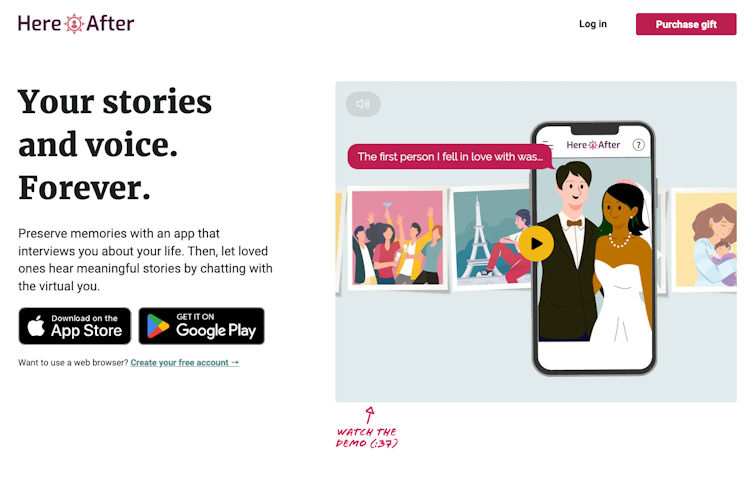Imagine a future where you get a message on your phone that your dead father’s “digital immortal” bot is ready. This promise of chatting with a virtual version of your loved one – perhaps through a virtual reality (VR) headset – is like stepping into a sci-fi movie, which is both thrilling and a little scary.
As you interact with this digital father, you find yourself on an emotional rollercoaster. You uncover secrets and stories you never knew about him, changing the way you remember the real person.
This is not a far-fetched, hypothetical scenario. The digital afterlife industry is growing rapidly. Several companies promise virtual reconstructions of deceased individuals based on their digital footprints.
From artificial intelligence (AI) chatbots and virtual avatars to holograms, this technology offers a strange mix of comfort and disruption. It can draw us into deeply personal experiences that blur the lines between past and present, memory and reality.
As the digital afterlife industry grows, it raises significant ethical and emotional challenges. These include concerns about consent, privacy, and the psychological impact on living people.
What is the digital afterlife industry?
VR and AI technologies are making virtual reconstructions of our loved ones possible. Companies in this niche industry use data from social media posts, emails, text messages, and voice recordings to create digital personalities that can interact with living people.
Although it is still a niche sector, the number of players in the digital afterlife industry is growing.
HereAfter allows users to record stories and messages during their lifetime, which can then be accessed posthumously by loved ones. MyWishes provides the ability to send pre-defined messages after death, allowing the deceased to remain present in the lives of the living.
Hanson Robotics has created robotic busts that interact with people using the deceased’s memories and personality traits. Project December gives users access to so-called “deep AI” so they can have text-based conversations with departed people.
Generative AI also plays a key role in the digital afterlife industry. These technologies enable the creation of highly realistic and interactive digital personalities. But the high level of realism can blur the line between reality and simulation. This can enhance the user experience, but can also cause emotional and psychological distress.

Technology ready for abuse
Digital afterlife technologies can aid the grieving process by providing continuity and connection with the deceased. Hearing a loved one’s voice or seeing their image can provide solace and help accept the loss.
For some of us, these digital immortals can be healing tools. They can help us preserve positive memories and feel close to loved ones even after they have passed away.
But for others, the emotional impact can be very negative, which can exacerbate grief rather than alleviate it. AI reconstructions of loved ones have the potential to cause psychological harm if the grieving person has unwanted interactions with them. This is essentially being subjected to “digital haunting”.
Other major issues and ethical concerns associated with this technology include consent, autonomy, and privacy.
For example, the deceased may not have consented to their data being used for a “digital afterlife.”
There is also a risk of misuse and data manipulation. Companies can exploit digital immortals for commercial gain, using them to advertise products or services. Digital personalities can be altered to express messages or behaviors that the deceased would never have endorsed.
We need regulation
To address the concerns associated with this rapidly emerging industry, we need to update our legal framework. We need to address issues such as digital estate planning, who will inherit the digital personality of the deceased, and digital memory ownership.
The European Union’s General Data Protection Regulation (GDPR) recognises privacy rights after death, but there are challenges to its enforcement.
Social media platforms control access to data of deceased users, often against the will of heirs, complicating matters with provisions such as “no right to survival”. Limiting platform practices hinder the effectiveness of GDPR. Comprehensive protection requires re-evaluating contractual rules alongside human rights.
The digital afterlife industry offers comfort and memory preservation, but also raises ethical and emotional concerns. Thoughtful regulation and the implementation of ethical guidelines can respect both the living and the dead, to ensure that digital immortality enhances our humanity.
what can we do?
Researchers have suggested several ethical guidelines and rules. Some of the recommendations are as follows:
- Obtaining informed and documented consent before creating digital personas from people before they die
- Age restrictions to protect vulnerable groups
- Clear disclaimers to ensure transparency
- and strong data privacy and security measures.
Drawing from ethical frameworks in archaeology, a 2018 study suggests treating digital remains as an integral part of personhood, and proposes regulations to ensure dignity, particularly in reconstruction services.
Dialogue between policymakers, industry and academia is crucial to developing ethical and regulatory solutions. Providers should also provide ways for users to respectfully end their interactions with digital personalities.
Through careful, responsible development, we can create a future where digital afterlife technologies honor our loved ones in a meaningful and dignified way.
As we navigate this brave new world, it’s important to balance the benefits of staying connected with our loved ones and the potential risks and ethical dilemmas.
By doing so, we can ensure that the digital afterlife industry develops in a way that honours the memory of the deceased and supports the emotional wellbeing of the living.![]()
(Author Arif Pardana is Associate Professor of Digital Strategy and Data Science, Monash University)
This article is republished from The Conversation under a Creative Commons license. Read the original article.
(Except for the headline, this story has not been edited by NDTV staff and is published from a syndicated feed.)







